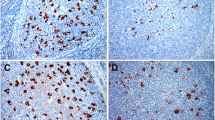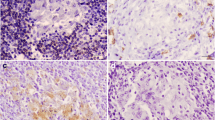Abstract
Monocytes from a buffalo were cultured in RPMI 1640 medium following separation of plasma by the erythrocyte sedimentation technique and subsequent separation of mononuclear cells by density gradient centrifugation. Growth of an organism considered to be Ehrlichia bovis was noticed in the cultured monocytes after 10 days. The inclusions were considered to be those of E. bovis from their morphology, staining characteristics and growth characteristics in culture, and by indirect immunofluorescence examination with an anti-E. canis serum. The utility of peripheral blood monocyte cultures opens the possibility of diagnosing the carrier status of ehrlichiosis in animals.
Similar content being viewed by others
REFERENCES
Czuprynski, C.J. and Hamilton, H., 1985. The effects of serum on the in vitro adherence and maturation of bovine monocytes. Veterinary Immunology and Immunopathology, 9, 189–193
Donatien, A. and Lestoquard, F., 1936. Rickettsia bovis nouvelle espèce pathogene pour le boeuf. Bulletin de la Societe de Pathologie Exotique, 29, 1057–1061
Hay, R.J., 1992. Cell line preservation and characterisation. In: R.I. Freshney (ed.), Animal Cell Culture. A Practical Approach, (Oxford University Press, New York), 114–118
Holland, C.J., Ristic, M., Cole, A.I., Johnson, P., Baker, G. and Goetz, T., 1985a. Isolation, experimental transmission and characterisation of causative agent of Potomac horse fever. Science, 227, 522–524
Holland, C.J., Ristic, M., Huxsoll, D.L., Cole, A.I. and Rapmund, G., 1985b. Adaptation of Ehrlichia sennetsu to canine blood monocytes: preliminary structural and serological studies with cell culture derived E. sennetsu. Infection and Immunity, 48, 363–371
Holland, C.J., Weiss, E., Burgdorfer, W., Cole, A.I. and Kakoma, I., 1985c. Ehrlichia risticii sp. nov.: etiological agent of equine monocytic ehrlichiosis (Synonym, Potomac Horse Fever). International Journal of Systematic Bacteriology, 34, 524–526
McDade, J.E., 1990. Ehrlichiosis-a disease of animals and humans. Journal of Infectious Diseases, 61, 609–617
Nyindo,B.A., Huxsoll, D.L. and Smith, A.R., 1971. Tropical canine pancytopenia: in vitro cultivation of the causative agent Ehrlichia canis. American Journal of Veterinary Research, 32, 1651–1658
Price, J.E. and Dolan, T.T., 1980. A comparison of the efficacy of imidocarb dipropionate and tetracycline hydrochloride in the treatment of canine ehrlichiosis. Veterinary Record, 107, 275–277
Rikihisa, Y., 1991. Cross reacting antigens between Neorickettsia helminthoeca and Ehrlichia species, shown by immunofluorescence and western immunoblotting. Journal of Clinical Microbiology, 29, 2024–2029
Sreekumar, C., Anandan, R., Balasundaram, S. and Rajavelu, G., 1996. Morphology and staining characteristics of Ehrlichia bovis. Comparative Immunology, Microbiology and Infectious Diseases, 19, 79–83
Uilenberg, G., 1993. In: Z. Woldehiwet and M. Ristic (eds), Rickettsial and Chlamydial Diseases of Domestic Animals, (Pergamon Press, Oxford), 269
Author information
Authors and Affiliations
Rights and permissions
About this article
Cite this article
Sreekumar, C., Anandan, R., Balasundaram, S. et al. Detection of an Ehrlichia bovis-like Organism in Cultured Buffalo Monocytes. Tropical Animal Health and Production 32, 67–72 (2000). https://doi.org/10.1023/A:1005270101276
Issue Date:
DOI: https://doi.org/10.1023/A:1005270101276




